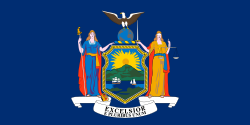 | |
| New York State public benefit corporation overview | |
|---|---|
| Formed | 1968 |
| Jurisdiction | Real estate within a defined area in the vicinity of U.N. headquarters in Manhattan |
| Headquarters | Two United Nations Plaza 27th Floor New York, NY 10017 [1] |
| New York State public benefit corporation executive |
|
| Website | www |
The United Nations Development Corporation (UNDC) is a public-benefit corporation in the U.S. state of New York that helps the United Nations with its real estate, office space, and development needs. It was created in 1968. The UNDC is permitted to develop and operate real estate only within a prescribed area (the "Development District") in the vicinity of the United Nations headquarters in Manhattan. The boundaries of the Development District and other powers of the Corporation are subject to change to the extent provided by additional legislation. [2]
